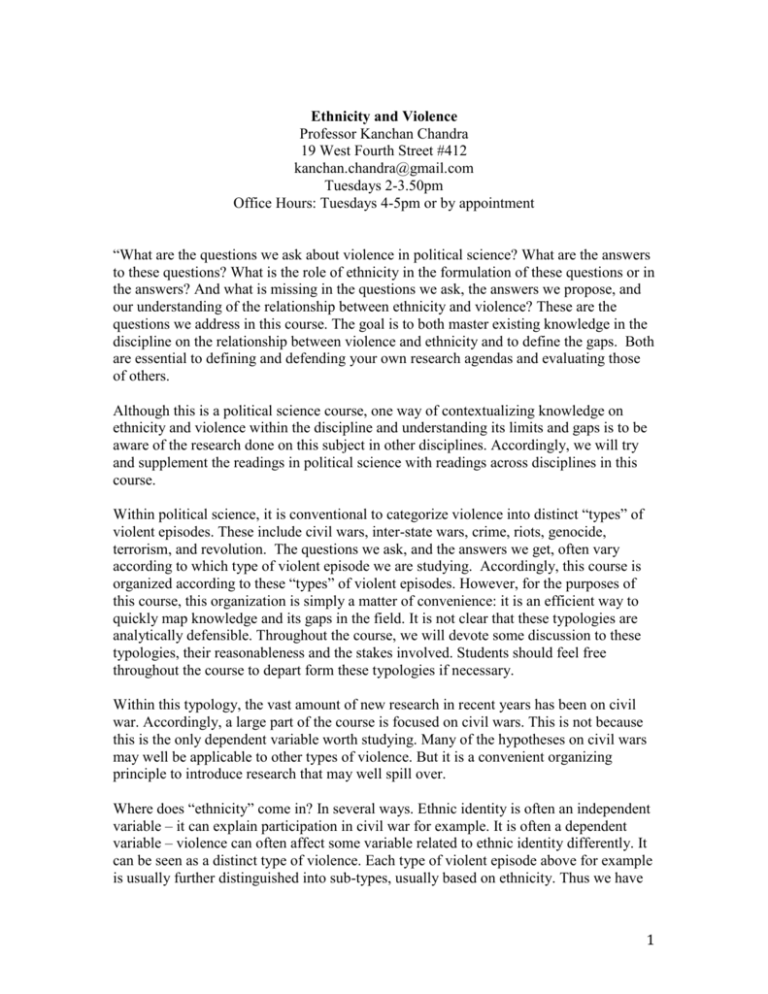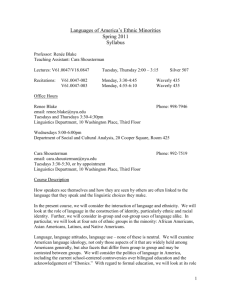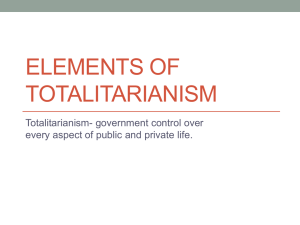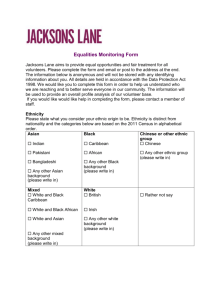Ethnicity and Violence - Department of Politics, New York University
advertisement

Ethnicity and Violence Professor Kanchan Chandra 19 West Fourth Street #412 kanchan.chandra@gmail.com Tuesdays 2-3.50pm Office Hours: Tuesdays 4-5pm or by appointment “What are the questions we ask about violence in political science? What are the answers to these questions? What is the role of ethnicity in the formulation of these questions or in the answers? And what is missing in the questions we ask, the answers we propose, and our understanding of the relationship between ethnicity and violence? These are the questions we address in this course. The goal is to both master existing knowledge in the discipline on the relationship between violence and ethnicity and to define the gaps. Both are essential to defining and defending your own research agendas and evaluating those of others. Although this is a political science course, one way of contextualizing knowledge on ethnicity and violence within the discipline and understanding its limits and gaps is to be aware of the research done on this subject in other disciplines. Accordingly, we will try and supplement the readings in political science with readings across disciplines in this course. Within political science, it is conventional to categorize violence into distinct “types” of violent episodes. These include civil wars, inter-state wars, crime, riots, genocide, terrorism, and revolution. The questions we ask, and the answers we get, often vary according to which type of violent episode we are studying. Accordingly, this course is organized according to these “types” of violent episodes. However, for the purposes of this course, this organization is simply a matter of convenience: it is an efficient way to quickly map knowledge and its gaps in the field. It is not clear that these typologies are analytically defensible. Throughout the course, we will devote some discussion to these typologies, their reasonableness and the stakes involved. Students should feel free throughout the course to depart form these typologies if necessary. Within this typology, the vast amount of new research in recent years has been on civil war. Accordingly, a large part of the course is focused on civil wars. This is not because this is the only dependent variable worth studying. Many of the hypotheses on civil wars may well be applicable to other types of violence. But it is a convenient organizing principle to introduce research that may well spill over. Where does “ethnicity” come in? In several ways. Ethnic identity is often an independent variable – it can explain participation in civil war for example. It is often a dependent variable – violence can often affect some variable related to ethnic identity differently. It can be seen as a distinct type of violence. Each type of violent episode above for example is usually further distinguished into sub-types, usually based on ethnicity. Thus we have 1 ethnic civil wars and non-ethnic civil wars, ethnic riots and non-ethnic riots and so on. Some types of violence, furthermore, such as genocide, are believed by definition to be driven by ethnicity. In each course meeting, therefore, we will start with violence broadly defined and then address at the end the question of how ethnicity is relevant, if at all. Students who do not have a background in studies of ethnic politics should read additional materials on ethnicity, starting with the chapters in Kanchan Chandra ed Constructivist Theories of Ethnic Politics (New York: Oxford University Press 2012). Requirements: The course grade depends on class participation (20%), 10 “review papers” (50%, 5% each), two research presentations based on the review papers (5% each) and a final paper (10 pages) outlining a research question due via email on May 6 (10% of the grade). As you can see, your performance in the course depends on keeping up each week, and not on one final product at the end of the course. There is no research paper for this course. Guidelines for the Review Paper: (1) It should answer a question, typically the question on the syllabus for that week. (2) It should focus on argument rather than summary. (3) This argument should consist of your take on an interpretation/distillation of the answer that the readings for the week give to the question (3) It should have one argument, not several (4) It should contain an annotated bibliography and (5) This will require careful and strategic reading (See guidelines on reading attached to the syllabus). February 4: What is Ethnicity? What is Violence? What is “Ethnic Violence? Kanchan Chandra, “What is Ethnic Identity: A Minimalist Definition”, Chapters 1 and 2 in Constructivist Theories of Ethnic Politics (New York: Oxford University Press, 2012) Brubaker, Rogers, and David Laitin. (1998). “Ethnic and Nationalist Violence.” Annual Review of Sociology 4: 423–452 Sambanis, Nicholas. 2004. “What Is Civil War? Conceptual and Empirical Complexities of an Operational Definition.” Journal of Conflict Resolution, 48(6): 814–58. Brass. Paul (1997). Theft of an Idol. Princeton NJ; Princeton University Press, Chapter 1 February 11: Why Individuals Participate in Civil Wars and What Does Ethnicity Have to Do with It? Wood, Elisabeth Jean. 2003. Insurgent Collective Action and Civil War in El Salvador. Cambridge and New York: Cambridge University Press. Weinstein, Jeremy M. 2007. Inside Rebellion: The Politics of Insurgent Violence. Cambridge and New York: Cambridge University Press. Weinstein, Jeremy M. 2005. “Resources and the Information Problem in Rebel Recruitment.” Journal of Conflict Resolution, 49(4): 598–624. 2 Petersen, Roger. 2001. Resistance and Rebellion: Lessons from Eastern Europe. Cambridge: Cambridge University Press. Lichbach, Mark Irving. 1994. “What Makes Rational Peasants Revolutionary? Dilemma, Paradox, and Irony in Peasant Collective Action.” World Politics, 46(3): 383–418. Lichbach, Mark Irving. 1995. The Rebel’s Dilemma. Ann Arbor: University of Michigan Press. Kalyvas, Stathis N., and Matthew Kocher. 2007. “How Free is ‘Free Riding’ in Civil Wars? Violence, Insurgency, and the Collective Action Problem.” World Politics, 59(2): 177–216. Humphreys, Macartan, and Jeremy M. Weinstein.2008. “Who Fights? The Determinants of Participation in Civil War.” American Journal of Political Science,52(2): 436–55. Gates, Scott. 2002. “Recruitment and Allegiance: The Microfoundations of Rebellion.” Journal of Conflict Resolution, 46(1): 111–30. Gurr, Ted Robert. 1971. Why Men Rebel. Princeton and Oxford: Princeton University Press. Beber, Bernd and Christopher Blattman. 2013. “The logic of child soldiering and coercion,” International Organization 67, 65–104. Lars-Erik Cederman, Kristian Skrede Gleditsch and Halvard Buhaug, Inequality, Grievances, and Civil War (New York: Cambridge University Press, 2013). Sambanis, Nicholas. 2001. “Do Ethnic and Nonethnic Civil Wars Have the Same Causes?: A Theoretical and Empirical Inquiry (Part 1).” Journal of Conflict Resolution, 45(3): 259–82. February 18: Why do Civil Wars Break Out? Why do Some Civil Wars Last Longer Than Others and What Does Ethnicity Have to Do With Either Outbreak or Civil War? James Fearon, “Ethnic War as a Commitment Problem” in Lake and Rothchild eds, The International Spread of Ethnic Conflict. (Princeton NJ: Princeton University Press, 1998). Collier, Paul, and Anke Hoeffier. 1998. "On Economic Causes of Civil War." Oxford Economic Papers 50 (4): 563-73. Barry Posen, “The Security Dilemma and Ethnic Conflict.” In Ethnic Conflict and International Security. Princeton, NJ: Princeton University Press, 1993. 3 Ross, Michael L. 2004. “How Do Natural Resources Influence Civil War? Evidence from Thirteen Cases.” International Organization, 58(1): 35–67. Ross, Michael L. 2004. “What Do We Know about Natural Resources and Civil War?” Journal of Peace Research, 41(3): 337–56. Ross, Michael L. 2006. “A Closer Look at Oil, Diamonds, and Civil War.” Annual Review of Political Science, 9: 265–300. Fearon, James D., and David D. Laitin. 2003. “Ethnicity, Insurgency and Civil War.” American Political Science Review 97 (1): 75–90. Vreeland, James Raymond. 2008. “The Effect of Political Regime on Civil War: Unpacking Anocracy.” Journal of Conflict Resolution, 52(3): 401–25. Miguel, Edward, Shanker Satyanath, and Ernest Sergenti. 2004. “Economic Shocks and Civil Conflict: An Instrumental Variables Approach.” Journal of Political Economy 112 (4): 725–54 Walter, Barbara F., and Jack Snyder, eds. 1999. Civil Wars, Insecurity, and Intervention. New York: Columbia University Press. Montalvo, Jose G., and Marta Reynal-Querol. 2005. “Ethnic Polarization, Potential Conflict, and Civil Wars.” American Economic Review, 95(3): 796–816. Justino, Patricia. 2009. “Poverty and Violent Conflict: A Micro-level Perspective on the Causes and Duration of Warfare.” Journal of Peace Research, 46(3): 315–33. Esteban, Joan, and Debraj Ray. 2008. “On the Salience of Ethnic Conflict.” American Economic Review, 98(5): 2185–2202. Paul Collier and Anke Hoeffler, 2004. “Greed and Grievance in Civil War,” Oxford Economic Papers 56 (4), 563‐595. Jack Snyder, 2000. From Voting to Violence: Democratization and Nationalist Conflict, New York, W. W. Norton. Lars-Erik Cederman, Andreas Wimmer and Brian Min. “What makes ethnic groups rebel? New data and new analysis”, in World Politics 62(1):87-119, 2010. Cederman,L.-E., Gleditsch, K.S., Salehyan, I. and Wucherpfennig, J. (2013). “Transborder Ethnic Kin and Civil War.” International Organization , 67 (2) 389 - 410 Cederman, L.-E., Gleditsch, K.S., and Hug, S. (2013). Elections and Ethnic Civil War. Comparative Political Studies 46(3):387-417 4 Cederman, L.-E., Weidmann, N.B., and Gleditsch, K.S. (2011). Horizontal Inequalities and Ethno-Nationalist Civil War: A Global Comparison. American Political Science Review 105(3):478-95 Cederman, L.-E., Girardin, L. and Gleditsch, K. S. (2009). Ethno-Nationalist Triads: Assessing the Influence of Kin Groups on Civil Wars . World Politics 61: 403-437 Cederman, L.-E. and Gleditsch, K. S. (2009). Introduction to Special Issue on "Disaggregating Civil War". Journal of Conflict Resolution 53: 487-495 James Fearon, Why Do Some Civil Wars Last So Much Longer Than Others? Journal of Peace Research 41, 3 (May 2004), 275-302. Sambanis, Nicholas, and Ibrahim A. Elbadawi. 2000. “External Interventions and the Duration of Civil Wars.” World Bank Policy Research Working Paper 2433. Reynal-Querol, Marta, and Jose G. Montalvo. 2007. “Ethnic Polarization and the Duration of Civil Wars.” World Bank Policy Research Working Paper 4192. Wucherpfennig, J., Metternich, N., Cederman, L.-E., and Gleditsch, Kristian S. (2012). Ethnicity, the State and the Duration of Civil War. World Politics 64(1):79-115 Nicholas Sambanis, “How Much War Will We See? Explaining the Prevalence of Civil War” (with Ibrahim Elbadawi). Journal of Conflict Resolution 46 (3): 307-334 (June 2002). February 25: What are the Forms of Violence During Civil War and What Does Ethnicity Have to do With These Forms, if Anything? Stathis Kalyvas, 2006. The Logic of Violence in Civil War. New York, Cambridge University Press. Wood, Elizabeth Jean. 2009. “Armed Groups and Sexual Violence: When Is Wartime Rape Rare?” Politics and Society, 37(1): 131–61. Wood, Elisabeth Jean. 2006. “Variation in Sexual Violence during War.” Politics and Society, 34(3): 307–42. Lyall, Jason. 2009a. “Does Indiscriminate Violence Incite Insurgent Attacks?: Evidence from Chechnya.” Journal of Conflict Resolution, 53(3): 331–62. Laia. Balcells, Continuation of Politics by Two Means: Direct and Indirect Violence in Civil War.” Journal of Conflict Resolution, Volume 55, No, 3 (2011), 397-422 Stathis N. Kalyvas and Matthew Adam Kocher, 2009. “The Dynamics of Violence in 5 Vietnam: An Analysis of the Hamlet Evaluation System,” Journal of Peace Research 46 (3), pp. 335–355. Jason Lyall, 2010. “Are Coethnics More Effective Counterinsurgents? Evidence from the Second Chechen War,” American Political Science Review 104 (1), pp. 1‐20. Stathis N. Kalyvas and Laia Balcells, “International System and Technologies of Rebellion: How the Cold War Shaped Internal Conflict.” Vol 104, No 3, August 2010, 415-529. Roger Petersen, Understanding Ethnic Violence: Fear, Hatred, and Resentment in Twentieth Century Eastern Europe. New York: Cambridge University Press, 2002. March 4: How Do Civil Wars End, What are the Effects of Civil War Ending, and What Does Ethnicity Have to do With Ending and Effects of Civil Wars, if Anything? Fortna, Virginia Page. 2004. “Does Peacekeeping Keep Peace? International Intervention and the Duration of Peace after Civil War.” International Studies Quarterly, 48(2): 269–92. Fortna, Virginia Page. 2004. Peace Time: Cease-Fire Agreements and the Durability of Peace. Princeton and Oxford: Princeton University Press. Tilly, Charles. 1992. Coercion, Capital, and European States, AD 990–1992. Malden, Mass. and Oxford: Blackwell. Tilly, Charles, ed. 1975. The Formation of National States in Western Europe. Princeton and Oxford: Princeton University Press. Salehyan, Idean, and Kristian Skrede Gleditsch. 2006. “Refugees and the Spread of Civil War.” International Organization, 60(2): 335–66 Blattman, Christopher and Jeannie Annan. 2010. “The Consequences of Child Soldiering,” Review of Economics and Statistics 42(4): 882–898. Blattman, Christopher. 2009. “From Violence to Voting: War and Political Participation in Uganda,”American Political Science Review 103(2): 231–247. Charles Tilly, 2003. The Politics of Collective Violence. Cambridge, Cambridge University Press, pp.1‐54. Saumitra Jha and Steven Wilkinson, Does Combat Experience Foster Organizational Skill? Evidence from Ethnic Cleansing during the Partition of South Asia.” American Political Science Review Vol 106, No 4, November 2012 6 Walter, Barbara F. 2004. “Does Conflict Beget Conflict? Explaining Recurring Civil War.” Journal of Peace Research, 41(3): 371–88. Humphreys, Macartan, and Jeremy M. Weinstein. 2007. “Demobilization And Reintegration.” Journal of Conflict Resolution 51: 531– 67. Ted Miguel and Edward Miguel and Gérard Roland, 2011. "The long‐run Impact of Bombing Vietnam, " Journal of Development Economics 96 (1), 1‐15. Roger Petersen, Western Intervention in the Balkans: The Strategic Use of Emotion in Conflict. (New York: Cambridge University Press, 2011) March 11: What are the Main Questions in the Study of Civil War? What are the Answers? What Is Missing? How is ethnicity relevant to the questions, answers or the gaps? Blattman, Christopher and Edward Miguel. 2010. “Civil War,” Journal of Economic Literature 48(1): 3–57. Chandra, Kanchan ed. Constructivist Theories of Ethnic Politics (New York: Oxford University Press, 2012). Chapters 1-4 and 10. Mamdani, Mamdani. Good Muslim, Bad Muslim. New York: Pantheon Books, 2004. Tambiah, Stanley. Buddhism Betrayed. Chicago: University of Chicago Press, 1992. March 18: No Class, Spring Break March 25: Revisiting the Link Between Ethnicity and Violence Blattman, Christopher and Edward Miguel. 2010. “Civil War,” Journal of Economic Literature 48(1): 3–57. Chandra, Kanchan ed. Constructivist Theories of Ethnic Politics (New York: Oxford University Press, 2012). Chapters 1-4 and 10. Mamdani, Mamdani. Good Muslim, Bad Muslim. New York: Pantheon Books, 2004. Tambiah, Stanley. Buddhism Betrayed. Chicago: University of Chicago Press, 1992. April 1: Riots Question for paper: What is a riot, and in what way is it different from civil war? Why do riots occur (and is the process distinct from why civil wars occur)? In what way does ethnicity figure, if at all, in the definition or causes of a riot (and is the role of ethnicity in defining and producing riots different from its role in civil war)? 7 Make sure to be explicit about your conceptualization of ethnicity in the paper. Brass. Paul (1997). Theft of an Idol. Princeton NJ; Princeton University Press, Chapters 4 and 7. Wilkinson, Steven I. 2004. Votes and Violence: Electoral Competition and Ethnic Riots in India. Cambridge Studies in Comparative Politics. Cambridge: Cambridge University Press. (Recall also Wilkinson’s chapter in Constructivist Theories of Ethnic Politics). Ashutosh Varshney, Ethnic Conflict and Civic Life (New Haven: Yale University Press, 2002) Donald Horowitz, Deadly Ethnic Riot (Berkeley: University of California Press, 2001). Recommended: Kakar, Sudhir (1996). The Colors of Violence: Cultural Identities, Religion, and Conflict. Chicago: The University of Chicago Press. Saumitra Jha, “Trade, Institutions, and Ethnic Tolerance: Evidence from South Asia.” American Political Science Review, Volume 107, Issue 4, November 2013. Anjali Thomas Bohlken and Ernest Sergenti, forthcoming. “Ethnic Violence and Economic Growth: An Empirical Investigation of Hindu‐Muslim Riots in India,” Journal of Peace Research. Scacco, Alexandra, 2012. Anatomy of a Riot: Why Ordinary People Participate in Ethnic Violence, manuscript Stanley J. Tambiah, 1996. Leveling Crowds: Ethnonationalist Conflicts and Collective Violence in South Asia. Berkeley, University of California Press Veena Das, Mirrors of Violence: Communities, Riots and Survivors in South Asia. (New Delhi: Oxford University Press 1990). Gyanendra Pandey, Construction of Communalism in Colonial North India (New Delhi: Oxford University Press, 1990). April 8: Ethnicity April 15: Ethnicity April 22: Categorizations of Violence April 29: New Approaches to the Study of Ethnicity and Violence 8 Chris Dawes Sigmund Freud, Group Psychology and the Analysis of the Ego (New York: Norton 1989) Allport, Gordon W. 1956. The nature of prejudice. New York: Doubleday. Milgram, S. (1963) Behavioral Study of Obedience. Journal of Abnormal and Social Psychology 67(4): Pgs. 371-378. V. Das, A. Kleinman, M. Ramphele and P. Reynolds (eds.) Violence and Subjectivity. Berkeley: University of California Press, 2000 April 1: Crime Diego Gambetta, The Sicilian mafia. The business of private protection. Cambridge MA: Harvard University Press, 1993. Dube, Arindrajit, Oeindrila Dube and Omar Garcia Ponce, “Cross-Border Spillover: US Gun Laws and Violence in Mexico.” American Political Science Review, Volume 107, Issue 3, August 2013, 397-417. Tilly, Charles. 1985. “Warmaking and Statemaking as Organized Crime.” In Peter Evans, Dietrich. Rueschemeye and Theda Skocpol eds, Bringing the State Back in (New York: Cambridge University Press). Bourgois, P. (1995) In Search of Respect: selling crack in El Barrio. New York: Cambridge University Press. Daly, M. and M. Wilson (1982) Homicide and Kinship. American Anthropologist 84(2): Pgs. 372-378. Sudhir Venkatesh, The Underground Economy of the Urban Poor. Cambridge MA: Harvard University Press, 2009. April 8: Genocide Verwimp, Philip. 2003. “Testing the Double-Genocide Thesis for Central and Southern Rwanda.” Journal of Conflict Resolution, 47(4): 423–42. Verwimp, Philip. 2005. “An Economic Profile of Peasant Perpetrators of Genocide: Micro-level Evidence from Rwanda.” Journal of Development Economics, 77(2): 297– 323. Brass, Paul. 2003. “The Partition of India and Redistributive Genocide in the Punjab 1946–47.” Journal of Genocide Research 5 (1): 71–101. 9 Benjamin Valentino, 2000. “Final Solutions: The Causes of Mass Killing and Genocide,” Security Studies 9 (3), 1‐59 Scott Straus, 2006. The Order of Genocide: Race, Power and War in Rwanda, Ithaca, Cornell University Press, Davenport, Christian and Allan Stam. 2012. “Rwandan Political Violence in Space and Time,” working paper, University of Michigan. Scott Straus, 2004. “How Many Perpetrators Were There in the Rwandan Genocide? An Estimate,”Journal of Genocide Research 6 (1), pp. 85‐98. Taylor, C. (1999) Sacrifice as Terror: the Rwandan genocide of 1994. Oxford: Berg. April 15: Terrorism Pape, Robert, “Methods and Findings in the Study of Suicide Terrorism.” American Political Science Review, Vol 102, No. 2, May 2008 Pape, Robert A. 2003. “The Strategic Logic of Suicide Terrorism.” American Political Science Review 97 (August): 343–61. Sandler, Todd, and Walter Enders. 2004. “An Economic Perspective on Transnational Terrorism.” European Journal of Political Economy, 20(2): 301–16. Gambetta, Diego. 2005. “Can We Make Sense of Suicide Missions?” In Making Sense of Suicide Missions, ed. Diego Gambetta, 259–300. Oxford and New York: Oxford University Press. Alan B. Krueger and Jitka Maleckova, 2003. “Education, Poverty and Terrorism: Is there a Causal Connection?” Journal of Economic Perspectives (17) 4, pp. 119‐144. Jacob N. Shapiro, 2007. “The Terrorist’s Challenge: Security, Efficiency, Control,” working paper, Stanford University. Gould, Eric D., and Esteban F. Klor. 2010. "Does Terrorism Work?" Quarterly Journal of Economics 125(4), 1459‐1510. Berman, Eli, Roxanne L. Euben, Gilles Kepel, David Laitin, Karen Rasler, and Ian Shapiro. 2007. “Understanding Suicide Terror.” Perspectives on Politics 5 (March): 117– 40. Mamdani, M. (2002) Good Muslim, Bad Muslim: a political perspective on culture and terrorism. American Anthropologist 104(3): 766-775. Revolutions 10 Theda Skocpol, States and Social Revolutions. New York: Cambridge University Press 1979 Moore, Barrington. 1993. Social Origins of Dictatorship and Democracy: Lord and Peasant in the Making of the Modern World. Boston: Beacon Press. Carlos Boix, Democracy and Redistribution. Princeton NJ: Princeotn University Press, 2003. Grossman, Herschel I. 1999. “Kleptocracy and Revolutions.”Oxford Economic Papers, 51(2):267–83. Timur Kuran, 1991. “Now Out of Never: The Element of Surprise in the East European Revolution of 1989,” World Politics 44 (1), 7‐48. Doug McAdam, 1986. “Recruitment to High‐Risk Activism: The Case of Freedom Summer,”American Journal of Sociology 92 (1), 64‐90. Jason Lyall, 2006. “Pocket Protests: Rhetorical Coercion and the Micro‐politics of Collective Action in Semi‐authoritarian Regimes,” World Politics 58 (3), 378‐412. Joshua A. Tucker, 2007. “Enough! Electoral Fraud, Collective Action Problems, and Post‐ Communist Cultural Revolutions, Perspectives on Politics 5 (3), pp. 535‐551. Samuel Huntington, Political Order in Changing Societies. New Haven: Yale University Press, 1968. Something on China/USSR (to come). 11 Reading Skills: The reading for this course is impossibly long. For most weeks, there is no person could read every word of every page of every reading in the assigned time. Luckily, you don’t have to. Your task is how to map the main features of a field – learn its topography – quickly, then select the handful of works you need to read carefully (and within these works the sections you have to read carefully), then distil, evaluate, and make connections across what you read, and write as you go so that you have something to build on when you are done. So think about our strategy. You will soon discover, if you have not already, that there is no correlation between effort and outcome. It is entirely possible to spend several hours reading something without “getting it.” And it is equally possible to spend less than a half-hour reading something else and getting to the heart of the argument. You will have to devise for yourselves ways to read efficiently. (Some of you may benefit from reading Aaron Wildavsky, Craftways, for reading skills as well as general professional advice). Here is what I would do (although you will of course have to work out your own strategies). 1. Figure out quickly the key question and key answer that each work is concerned with. This should take approximately 3-4 hours (it may take longer the first time). Skim, read the abstracts, jacket blurbs, often short reviews published elsewhere. Take notes in an excel spreadsheet or something similar so that you can make connections quickly across what you encounter. Ask questions as you go, and note them and the answers somewhere. 2. When you know what the aerial map of a field looks like, decide on the question that you want to focus on. Then select the works to focus on accordingly. 3. When you decide what to read closely, read it first for the forest and not the trees. Ask – what is the question it is concerned with, what is the answer, what is the logic, what data or other form of evidence does it employ, what are the implications/connections to other works, and what do you think of all of the above. To do this, you will need to skim the piece as a whole, and then identify the handful of pages that require a very slow and careful read. 4. Read actively: do not simply soak up the reading for what the author wants to tell you, but approach it with questions, and try to answer them for yourself as you make your way through. 5. Use other peoples’ skills: you do not have to do all the work yourself. It is not “cheating” if you talk through the argument with someone else before or after you delve in, or look at reviews for explication, or form reading groups where you can discuss the argument with each other. 12 6. Write in order to read. Use diagrams if necessary: often, the structure of an argument can be most clearly expressed if you “draw” it, using arrows and lines, than by trying to understand it in words. 7. Organize your notes in a way that makes retention and information retrieval possible: you could use index cards, annotated bibliographies, database programmes like Filemaker Pro etc. 13









